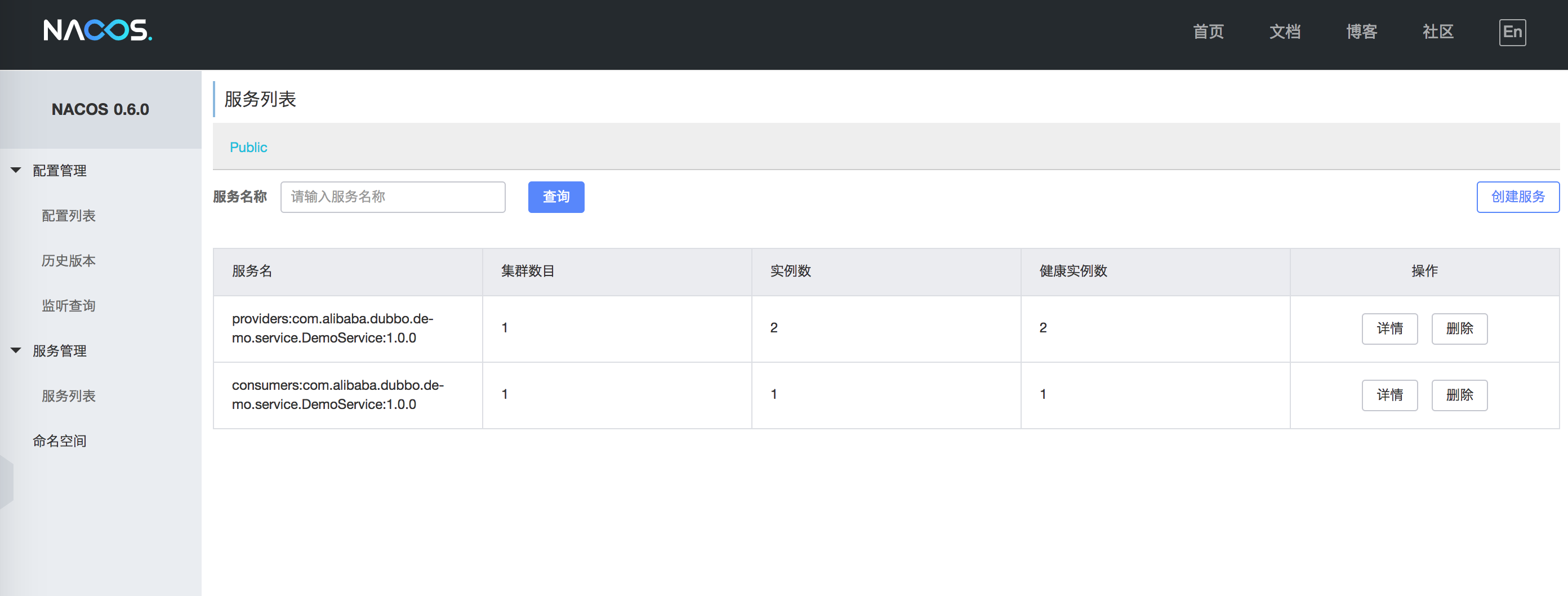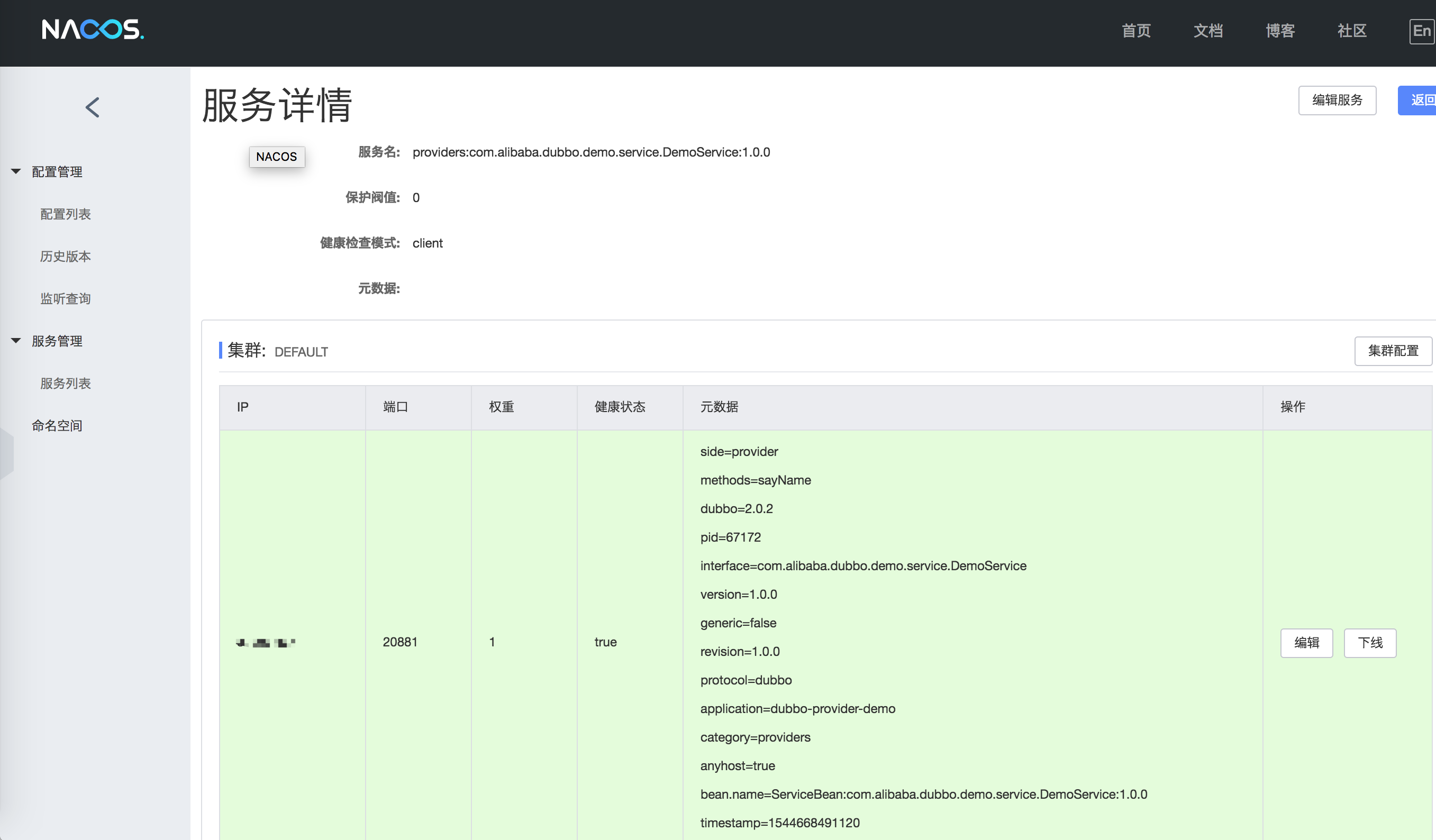Use Nacos as a Registry for Automatic Service Discovery
This example demonstrates automatic service discovery using Nacos as a registry based on a Spring Boot application. You can view the complete example code.
1 Basic Configuration
1.1 Add Dependencies
For Spring Boot applications, use the following spring-boot-starter:
<dependency>
<groupId>org.apache.dubbo</groupId>
<artifactId>dubbo-spring-boot-starter</artifactId>
<version>3.3.0</version>
</dependency>
<dependency>
<groupId>org.apache.dubbo</groupId>
<artifactId>dubbo-nacos-spring-boot-starter</artifactId>
<version>3.3.0</version>
</dependency>
Non-Spring Boot users can add dubbo and nacos-client dependencies:
<dependencies>
<dependency>
<groupId>org.apache.dubbo</groupId>
<artifactId>dubbo</artifactId>
<version>3.3.0</version>
</dependency>
<dependency>
<groupId>com.alibaba.nacos</groupId>
<artifactId>nacos-client</artifactId>
<version>2.1.0</version>
</dependency>
</dependencies>
1.2 Nacos Version Mapping
| Dubbo | Recommended Nacos Version | Nacos Compatibility Range |
|---|---|---|
| 3.3.0 | 2.3.0 | 2.x |
| 3.2.21 | 2.1.0 | 2.x |
| 3.1.11 | 2.0.9 | 2.x |
| 3.0.10 | 2.0.9 | 2.x |
| 2.7.21 | Latest 1.x Version | 1.x |
| 2.6.0 | Latest 1.x Version | 1.x |
1.3 Configure and Enable Nacos
# application.yml (Spring Boot)
dubbo
registry
address: nacos://localhost:8848
or
# dubbo.properties
dubbo.registry.address=nacos://localhost:8848
or
<dubbo:registry address="nacos://localhost:8848" />
2 Advanced Configuration
2.1 Authentication
# application.yml (Spring Boot)
dubbo
registry
address: nacos://localhost:8848?username=nacos&password=nacos
or
# dubbo.properties
dubbo.registry.address: nacos://nacos:nacos@localhost:8848
2.2 Custom Namespace
# application.yml (Spring Boot)
dubbo:
registry:
address: nacos://localhost:8848?namespace=5cbb70a5-xxx-xxx-xxx-d43479ae0932
or
# application.yml (Spring Boot)
dubbo:
registry:
address: nacos://localhost:8848
parameters.namespace: 5cbb70a5-xxx-xxx-xxx-d43479ae0932
2.3 Custom Group
# application.yml
dubbo:
registry:
address: nacos://localhost:8848
group: dubbo
If not configured, the group is specified by Nacos by default. The group and namespace represent different isolation levels in Nacos; generally, a namespace is used to isolate different users or environments, while a group is used to further categorize data within the same environment.
2.4 Register Interface-level Consumers
Starting from Dubbo 3.0.0, a parameter was added to indicate whether to register consumers. To register the consumer in the Nacos registry, set the parameter (register-consumer-url) to true; the default is false.
# application.yml
dubbo:
registry:
address: nacos://localhost:8848?register-consumer-url=true
or
# application.yml
dubbo:
registry:
address: nacos://localhost:8848
parameters.register-consumer-url: true
2.5 More Configurations {#35-more-configurations]
| Parameter Name | Description | Default Value |
|---|---|---|
| username | Username for connecting to Nacos Server | nacos |
| password | Password for connecting to Nacos Server | nacos |
| backup | Backup address | empty |
| namespace | ID of the namespace | public |
| group | Group name | DEFAULT_GROUP |
| register-consumer-url | Whether to register the consumer | false |
| com.alibaba.nacos.naming.log.filename | Log filename during initialization | naming.log |
| endpoint | Specified connection point to connect to Nacos Server, can refer to documentation | empty |
| endpointPort | Port of the specified connection point to Nacos Server, can refer to documentation | empty |
| endpointQueryParams | Query parameters for endpoint | empty |
| isUseCloudNamespaceParsing | Whether to parse the namespace parameter in a cloud environment | true |
| isUseEndpointParsingRule | Whether to enable endpoint parameter rule parsing | true |
| namingLoadCacheAtStart | Whether to prioritize reading local cache on startup | true |
| namingCacheRegistryDir | Specify cache subdirectory, location is …/nacos/{SUB_DIR}/naming | empty |
| namingClientBeatThreadCount | Thread pool size for client heartbeats | half of the machine’s CPU count |
| namingPollingThreadCount | Thread pool size for client timed polling data updates | half of the machine’s CPU count |
| namingRequestDomainMaxRetryCount | Number of retries for client requests to Nacos Server via HTTP | 3 |
| namingPushEmptyProtection | Whether to enable protection when there are no valid (healthy) instances; if enabled, it will use old service instances | false |
| push.receiver.udp.port | Client UDP port | empty |
After version 1.0.0 of nacos-server, clients can report instances with specific metadata to the server to control instance behaviors.
| Parameter Name | Description | Default Value |
|---|---|---|
| preserved.heart.beat.timeout | Time (in milliseconds) for an instance to go from healthy to unhealthy without sending heartbeats | 15000 |
| preserved.ip.delete.timeout | Time (in milliseconds) for the server to remove the instance after it stops sending heartbeats | 30000 |
| preserved.heart.beat.interval | Interval time (in milliseconds) for the instance to report heartbeats | 5000 |
| preserved.instance.id.generator | Instance ID generation strategy; when the value is snowflake, it starts increasing from 0 | simple |
| preserved.register.source | The type of service framework during instance registration (e.g., Dubbo, Spring Cloud, etc.) | empty |
These parameters can be configured similarly to namespace by extending parameters in Nacos, such as
dubbo.registry.parameters.preserved.heart.beat.timeout=5000
3 Working Principle
In a previous section, we explained the difference between application-level service discovery and interface-level service discovery. Below are the specific storage structures of both modes in Nacos.
3.1 Dubbo2 Registration Data
Then, restart your Dubbo application, and the service provider and consumer information in Dubbo can be displayed in the Nacos console:

As shown in the figure, the information with the service name prefix providers: is the metadata of the service provider, while consumers: represents the metadata of the service consumer. Click “Details” to view service status details:

3.2 Dubbo3 Registration Data
The application-level service discovery “service name” is the application name.
Dubbo3 defaults to a dual registration mode of “application-level service discovery + interface-level service discovery,” so both application-level services (application name) and interface-level services (interface name) will appear in the Nacos console. You can change the registration behavior by configuring
dubbo.registry.register-mode=instance/interface/all.